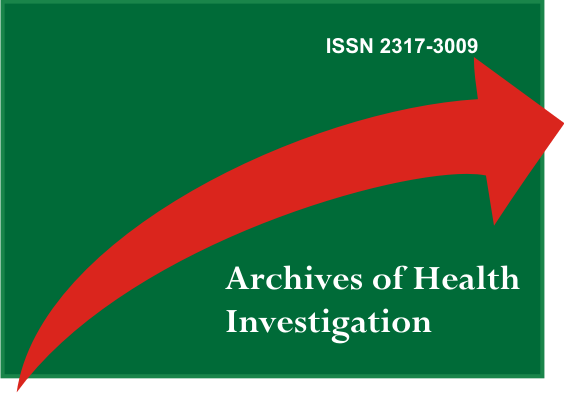Resistência a Tração de um Sistema Adesivo em Dentina Seca e em Dentina
Abstract
A complexa constituição da dentina gera muitas pesquisas para o desenvolvimento de um sistema adesivo que desempenhe o papel ideal para suas adversidades, que incluem a diversidade da composição morfológica e química, e a camada de esfregaço que é composta de sangue, saliva, bactérias e smear plug. O presente trabalho tem o objetivo de verificar a eficácia do sistema adesivo XP Bond - Dentsply® quanto à sua resistência adesiva em dentina seca e em dentina úmida. Os materiais e métodos utilizados para o desenvolvimento deste estudo in vitro foram compostos por 30 incisivos bovinos embutidos em resina epóxi, que tiveram sua superfície vestibular desgastada, removendo o esmalte e expondo a dentina superficial e em seguida, foram divididos em 2 grupos. O grupo dentina seca teve sua estrutura dental seca por papel absorvente e jato de ar e no grupo dentina úmida foi removido apenas o excesso de água com papel absorvente, posteriormente ambos receberam a aplicação do adesivo conforme recomendação do fabricante e então foram confeccionados os cones invertidos em resina composta para que os mesmos pudessem ser submetidos ao teste de tração. Este teste resultou em uma média de 19,62 ± 9,51 Megapascal para o grupo dentina úmida, enquanto que o grupo dentina seca apresentou uma média de 13,27 ± 4,19 Megapascal, constatando-se uma diferença estatística significante com p = 0,02865. Portanto, concluiu-se que o sistema adesivo tem efetiva eficácia em dentina úmida, e em dentina seca sua resistência adesiva não é igualmente eficiente.Palavras chave: Dentina, Resistência à tração, Adesividade.
Downloads
References
Marshall Junior GW, Marshall SJ, Kinney JH, Balooch M. The dentin substrate: structure and properties related to bonding. J Dent. 1997; 25: 441-58.
Oliveira SSA, Pugach MK, Hilton JF, Watanabe LG, Marshall SJ, Marshall Junior GW. The influence of the dentin smear layer on adhesion: a self-etching primer vs. a total-etch system. Dent Mater. 2003; 19: 758-67.
Rosales-Leal JI, Osorio R, Holgado_Terriza JA, Cabrerizo-Vílchez MA, Toledano M. Dentin wetting by four adhesive systems. Dent Mater. 2001; 17: 526-32.
Buonocore MG. A simple method of increasing the adhesion of acrylic filling materials to enamel surfaces. J Dent Rest. 1955; 34: 849-53.
Pashley DH, Carvalho RM. Dentine permeability and dentine adhesion. J Dent. 1997; 25: 335-72.
Kanca J. Resin bonding to wet substrate. Bonding to dentin. Quintessence Int. 1992; 23:39-41
De Minck J, Van Landuyt K, Peumans M, Poitevin A, Lambrechts P, Braem M, et al. A critical review of the durability of adhesion to tooth tissue: methods an results. J Dent Res. 2005; 84: 118-32.
Tay FR, Gwinnett JA, Wei SHY. Micromorphological spectrum from overdrying to overwetting acid-conditioned dentin in water-free, acetone-based, single- bottle primer/adhesives. Dent Mater. 1996; 12: 236-44.
Pashley DH, Carvalho RM, Tay FR, Agee KA, Lee KW. Solvation of dried dentin matrix by water and other polar solvents. Am J Dent. 2002; 15: 97-102.
Van Meerbeek B, De Munck J, Yoshida Y, Inocue S, Vargas M, Vijay P, et al. Buonocore memorial lecture. Adhesion to enamel and dentin: current status and future challenges. Oper Dent. 2003; 28: 215-35.
Dentsply. Disponível em: http://www.dentsply.com.br/hotsite/xpbond/faq.htm. Acesso em: 05 out 2009.
Tay FR, Gwinnett AJ, Pang KM, Wei SHY. Resin permeation into acid-conditioned, moist and dry dentin: a paradigm using water-free adhesive primers. J Dent Res. 1996; 75: 1034-44.
Tay FR, Gwinnett AJ, Pang KM, Wei SHY. "The overwet phenomenon": A TEM study on possible mechanisms. J Dent Res. 1995; 74: 402. (IADR Abstract 15).
Tay FR, Gwinnett AJ, Wei SHY. The overwet phenomenon: a scanning electron microscopic study of surface moisture in the acid-conditioned, resin-dentin interface. Am J Dent. 1996; 9: 100-4.
De Minck J, Van Landuyt K, Peumans M, Poitevin A, Lambrechts P, Braem M, et al. A critical review of the durability of adhesion to tooth tissue: methods an results. J Dent Res. 2005; 84: 118-32.
Tay FR, Pashley DH. Water- treeing a potential mechanism for degradation of dentin adhesives. Am J Dent. 2003; 16: 6-12.
Tay FR, Pashley DH, Suh BI, Carvalho RM, Itthagarun A. Single-step adhesives are permeable membranes. J Dent 2002; 30: 371-82.
Reis AF, Oliveira MT, Giannini M, De Goes MF, Rueggeberg FA. The effect of organic solvents on one-bottle adhesives' bond strength to enamel and dentin. Oper Dent. 2003; 28: 700-6.
Perdigão J. Moist vs. dried dentin: FESEM evaluation of alcohol-based adhesives. IADR/AADR/CADR 85th general Session and Exhibitin.2007.
Perdigão J, Van Meerbeek B, Lopes MM, Ambrose WW. The effect of a re-wetting agent on dentin bonding. Dent Mater. 1999; 15: 282-95.
Reis A, Loguercio AD, Azevedo CLN, Carvalho RM, Singer JM, Grande RHM. Moisture spectrum of desmineralized dentin for adhesive systems with different solvent bases. J Adhes Dent. 2003; 5: 183-92.
Susin AH, Vasconcellos WA, Saad, JRC, Oliveira Junior OB. Tensile bond strength of self-etching versus total-etching adhesive systems under different dentinal substrate conditions. Braz Oral Res. 2007; 21: 81-6.


